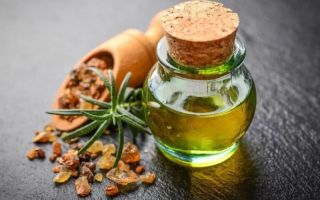Content
The properties of myrrh essential oil and other herbal preparations are of great interest. In folk medicine, pomace, tincture and tree resin are used for the treatment of acute and chronic diseases.
What it looks like and where it grows
Commiphora myrrh, or myrrh (Commiphora myrrha), is a plant from the Burzer family. It looks like a small tree up to 3 m tall with a spreading crown, branches at the ends are covered with sharp thorns. The leaves of myrrh are predominantly trifoliate, although sometimes only the middle plate develops. During the decorative period, the plant produces bright blood-red buds with twisted petals, combined into small graceful panicles. Then drupes ripen in place of the flowers.
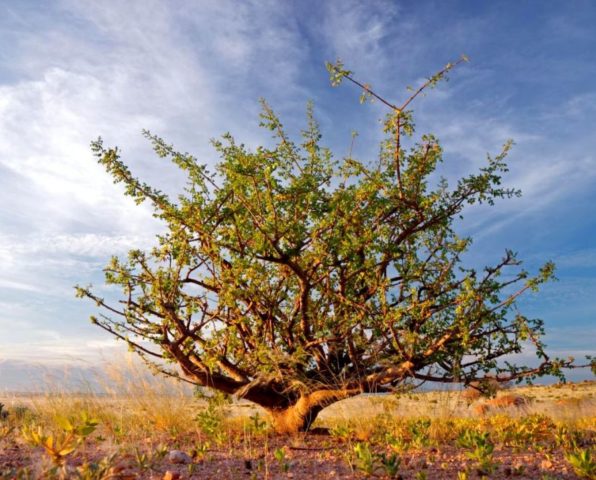
Myrrh naturally grows in Sudan, Somalia, Arabia and Ethiopia, Yemen and Sudan. You can meet it in arid areas from the Red Sea to the Indian Ocean.
Chemical composition
The properties of the herb myrrh, resin and essential oil are due to the chemical composition of the plant. Various parts of the valuable tree contain:
- elemol and elemene;
- bisabolic and germacrene D;
- gums and resins;
- curtseren and kadinen;
- linalool;
- mucus;
- vitamins;
- alpha santalen and selenene.
The active ingredients in myrrh in excess amounts can harm the body. But in small doses, they have a beneficial effect on health and improve the condition for various ailments.
Properties of the myrrh plant
When used carefully, myrrh medicines have a beneficial effect on the body. Namely:
- promote the healing of wounds, ulcers and abscesses, eliminate suppuration;
- help with nervous disorders and chronic insomnia;
- relieve bleeding gums and soothe pain;
- accelerate metabolic processes and improve appetite;
- promote recovery from bronchitis and sore throat;
- stimulate libido in men and women;
- promote rapid weight loss and remove various toxins from the body;
- relieve arthritis, gout and rheumatism;
- relieve pain and inflammation in hemorrhoids.
Myrrh is used for the prevention and treatment of cancer. Especially often it is advised to use it in the treatment of cancer of the reproductive organs.

Properties of myrrh essential oil
Traditional medicine recipes are used for treatment mainly with myrrh essential oil. It contains in its composition a huge amount of valuable substances and at the same time is the most affordable for purchase. Myrrh grows exclusively in arid tropical and African regions, so it is difficult to find fresh shoots, leaves, roots and even resin. The essential oil, meanwhile, is freely available from a pharmacy or specialty store.
Myrrh extract is known for its cosmetic properties. It is used to combat rashes and to smooth out scars, with the first wrinkles and excessive dryness of the skin. In addition, essential oil:
- refreshes complexion and tightens its contours;
- disinfects any skin lesions and promotes their healing;
- activates the synthesis of collagen and elastin, helps to maintain youth;
- eliminates dark circles and bags under the eyes;
- reduces pigmentation and eliminates blackheads and blackheads;
- improves subcutaneous blood circulation and fights spider veins.
The essential oil is used as an antibacterial and antifungal agent. With its help, you can speed up recovery from colds and increase immunity.
Preparation and application methods
At home, medicinal myrrh is rarely processed, since the tree does not grow in temperate latitudes, and its leaves and shoots are usually not available for collection. Essentially, essential oil is used for treatment in pure form or in combination with other components.
Myrrh tincture
Myrrh tincture is prepared on the basis of the plant's essential oil. The recipe looks like this:
- 250 ml of pure drinking water is poured into a glass.
- Add 5-7 drops of myrrh oil and stir.
The resulting product is used mainly for rinsing the mouth and throat. Bitter-tasting tincture has good healing properties, prevents the development of infections, fights bacteria.
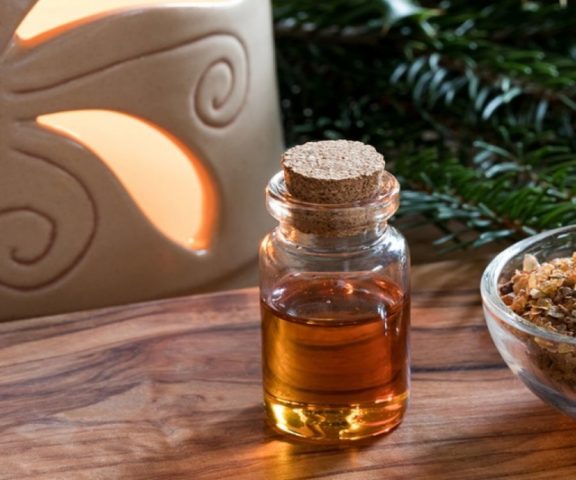
Myrrh essential oil
Myrrh essential oil is obtained by distilling the resin of the tree. The finished product has a pleasant shade from light yellow to rich amber, as well as a characteristic "smoky" aroma with bitterness.
Myrrh essential oil is in demand in religious ceremonies and in aromatherapy, in cosmetology and in the care of problem skin. In ancient times, pomace was used for wound healing and for embalming. Currently, myrrh essential oil is used:
- to eliminate acne and blackheads;
- to rejuvenate the epidermis;
- to quickly restore damaged skin;
- to relieve pain with bruises and joint ailments;
- to improve digestion;
- to strengthen hair and stimulate their growth.
Using myrrh essential oil on the body can reduce cellulite and make stretch marks less visible.
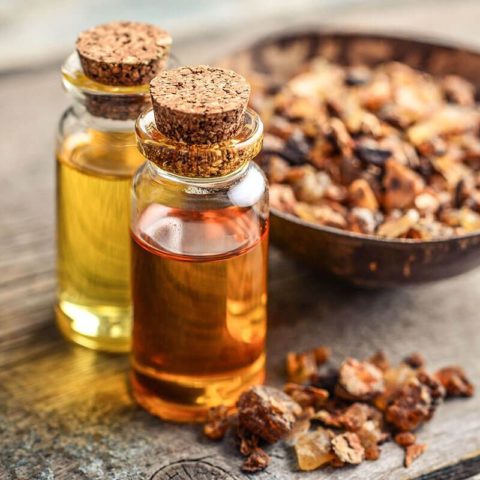
The use of myrrh in medicine
Traditional medicine offers many recipes for myrrh essential oil, despite its relative rarity. The algorithms for using pomace at home are quite simple.
For constipation
For chronic constipation, a home massage with essential myrrh extract can be performed. A few drops of the product are applied to the palm of your hand and rubbed into the lower abdomen in a clockwise circular motion. This procedure warms up tissues well and stimulates the intestines to work, helping to free it from toxins without using a laxative.
With stomatitis and gingivitis
The anti-inflammatory properties of myrrh essential oil help with irritated and bleeding gums, ulcers and scratches. Such a remedy gives a good effect:
- Ten drops of wheat germ oil are mixed with five drops of myrrh.
- Three drops of essential orange pomace are added.
- Bring to homogeneity.
The resulting mixture is applied with a cotton pad or stick to the affected gums for disinfection and quick healing.
With bruises
An alcoholic tincture of myrrh resin is good for severe bruises, severe bruising and pain.The tool is done like this:
- Measure 50 g of myrrh resin and pour in an equal amount of strong alcohol.
- Seal the container and shake.
- Put away in a dark warm place for a week.
The finished tincture is filtered and the painful areas are rubbed with a drug.
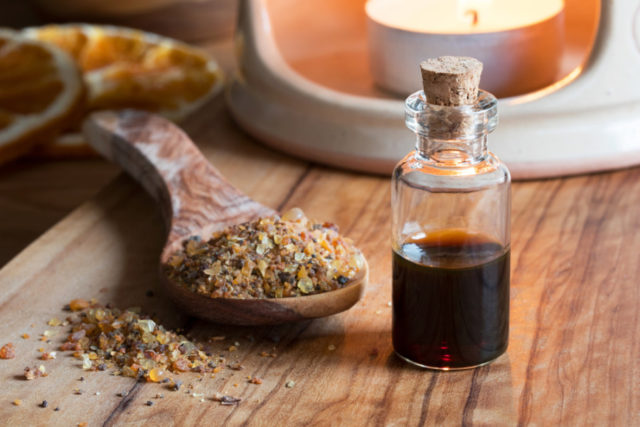
With migraines
Myrrh essential oil has a pleasant and not too intrusive scent. When inhaled, it relieves vascular spasms and promotes relaxation, so it helps with most migraines.
To eliminate the headache, it is enough to apply a drop of funds to the temples and rub in lightly. You do not need to make strong movements.
With gastritis
The use of myrrh resin is beneficial for hyperacid gastritis. The remedy regulates the secretion of gastric juice, slows down the production of hydrochloric acid, helps with heartburn and belching. A drug to improve digestive processes is done as follows:
- Dissolve 10 g of myrrh resin in a glass of water.
- Mix well.
The product is divided into three equal portions and taken throughout the day.
With weakened immunity
The beneficial substances in myrrh essential oil strengthen the immune system in the autumn-winter period against the background of a lack of vitamins. The following remedy is recommended for use:
- Pour 100 ml of honey or jam into a small container.
- Add 5-6 drops of myrrh essential oil.
- Mix the components thoroughly.
You need to use a treat on a small spoon up to four times a day. They take sweet medicine on a full stomach along with hot tea.
For muscle pain
The relaxing properties of myrrh oil can help improve bruises and muscle cramps. Traditional medicine suggests making compresses:
- Add 5 g of salt to 200 ml of clean, lukewarm water.
- Stir thoroughly until the grains are completely dissolved.
- Seven drops of myrrh essential oil are added.
In the resulting product, a cotton cloth is moistened, squeezed and applied to a sore spot. You need to keep the compress until it dries completely.

With a runny nose
Myrrh essential oil helps to relieve nasal congestion and restore free breathing. In case of a cold, it is recommended to carry out inhalations first of all:
- In a small saucepan, heat 1 liter of water until hot.
- Four drops of myrrh essential oil are added.
- They bend over the container and breathe in the steam for five minutes, covering their heads with a towel.
Inhalation during the procedure should be done very carefully and slowly so as not to burn the mucous membranes.
For skin ailments
The healing properties of myrrh essential oil can be used for eczema, dermatitis, and irritations. A simple ointment is prepared at home:
- Warm 20 ml of vegetable oil until warm.
- Add five drops of myrrh ether extract.
- Stir.
The product is rubbed into the affected areas with gentle movements, and after ten minutes it is washed off with warm water and natural soap. Oil with the addition of myrrh ether softens the epidermis well, relieves redness and itching.
Application in cosmetology
The valuable properties of essential myrrh oil are often used in facial skin care. There are several algorithms for using pomace.
Rejuvenating mask
When the first wrinkles appear and with general fading of the skin, you can do the following mask:
- Add five drops of myrrh ether to a glass of warm water.
- Stir thoroughly.
- Moisten a clean cloth in the solution.
The mask must be applied to the face for 20 minutes. After the expiration date, you need to wash with lukewarm water.
Mask for dry skin
If the epidermis is too dry, myrrh is mixed with additional ingredients. The mask recipe looks like this:
- Heavy cream in a volume of 30 ml is mixed with an equal amount of oat flour.
- Bring to the state of a homogeneous gruel.
- Add five drops of myrrh essential oil and mix again.
The product is spread in a thin layer over the face and left to dry. Then the remnants of the mask are removed with water, and the clean skin is treated with a moisturizer.
Hair strengthening mask
The valuable properties of myrrh tree essential oil can be used for weakened hair prone to hair loss. Home cosmetology suggests making the following mask:
- A large spoonful of castor oil is mixed with the egg yolk.
- Beat the ingredients thoroughly and add liquid vitamin E from the capsule.
- Contribute eight drops of myrrh essential oil.
- Mix the ingredients again.
- Distribute through the hair along the entire length with a comb.
The curls are wrapped with cling film and a towel and the mixture is left for 40 minutes.

Contraindications
Biologically active substances in myrrh can be not only beneficial, but also harmful. You cannot use essential oil and other plant-based products:
- during pregnancy and during feeding;
- with uterine bleeding;
- with acute inflammatory processes in the intestine;
- with exacerbation of pancreatitis and stomach ulcers;
- with diabetes mellitus;
- with chronic severe ailments of the kidneys and liver;
- with individual allergies.
It is recommended to use myrrh-based essential oil by external means. Inside the squeeze is used only when absolutely necessary, in minimal dosages and in diluted form.
Collection and procurement
To prepare the essential oil in the arid regions of the planet, the resin of the myrrh tree is harvested. Special incisions are made in the bark, from which a yellow-brown or grayish juice flows. After a while, it dries up and turns into resin balls. They are collected by hand and subjected to distillation or extraction to isolate the essential oil. The resin is also suitable for the preparation of water-based tinctures and infusions.
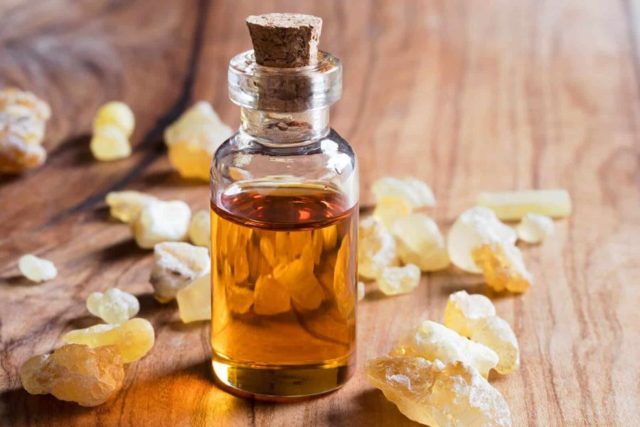
The magical properties of myrrh essential oil
Myrrh belongs to the category of sacred trees. Numerous mystical properties are attributed to the essential oil from the resin of the plant. According to legends, myrrh evens out and brightens the aura, elevates the thoughts and desires of a person when using and inhaling the aroma, relieves of vain experiences.
Essential oil helps you see the truth in all situations and uncover lies and intrigue. The rich scent of myrrh promotes love and glory.
Conclusion
The properties of myrrh essential oil are used in folk medicine and in cosmetology. When used correctly, pomace strengthens hair and rejuvenates the skin, and helps to cope with internal inflammation and intestinal disorders.

